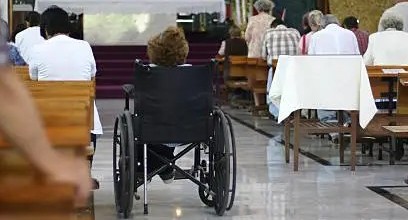Inclusivity and The Faith Community
National Liturgical Council

In the Gospels we learn that Jesus made time for all people – especially those who were outcast or left behind by society. In his ministry he made time to be with, give hope to and heal those who were poor, diseased, disabled or different in some way. He brought close Zaccheus, a man who was not trusted by the community, probably shunned by most. He healed those who could not see, could not hear, couldn’t move. He healed those with frightening illnesses, even putting himself at risk of being outcast himself.
Jesus modelled a community of love, acceptance and welcome. He was not afraid to speak out about unhelpful attitudes and practices in the faith community.
As Christian people and in our Church communities, we aim to model our lives on Christ’s life: to love each other, help and guide each other to live “good” lives, and reach out to and help people in need. We aim to spread the word of God and His love to all people. We believe that all people are created in God’s image and that he loves us all. The faith community is to be a place of joy, life and learning. We welcome all who want to join us – or do we, really?
There is a significant prevalence of disability in Australian society – close to one in five people across the life span. What are the implications for the faith community? How might people with special needs be welcomed during Mass, at morning tea after Mass, as members of parish committees, as Ministers of the Word or Eucharist?
Of course, many forms of impairment are not easily visible. An example here is people who are neurodivergent – people who have autism spectrum disorder or attention deficit hyperactivity disorder. There is no disability to be seen, except perhaps in subtle ways like the way the person communicates, or how they cope with noise that is too much for them to process. Commonly, the neurodivergent person will struggle with aspects of the community celebration of Mass and find the experience exhausting as they deal with being overwhelmed. Many will find it too stressful to return on a regular basis.
People with disability and their families yearn to be welcomed and to participate as full members of the faith community. The question of whether a faith community is indeed a place of love, joy, justice and welcome for people with disability is a very complex question. It involves real enquiry and deep thought, wrestling with individual attitudes and biases, as well as those of the parish generally.
Australian based resources have been developed by the Luke 14 program of the Christian Blind Mission (CBM) created with people with disabilities, biblically based and incorporating Australian disability inclusion best practice. They have shared a disability inclusion checklist. This is an excellent introductory resource, and a great place to start.
Being an inclusive faith community and helping people find ways to be involved relates not only to people with disability, but also to First Nations Peoples, people from different cultures, those affected by mental health issues, people experiencing poverty, people of all ages and people of diverse genders. Some Australian Dioceses have developed Reconciliation Action Plans which guide efforts to walk with First Nations Peoples and communities. These are important documents for parishes to be familiar with.
The task of creating inclusive faith communities is the work of all the baptised, and aims to ensure that all people may experience the unconditional acceptance and embrace of Jesus in whose name we gather to celebrate the liturgy.
